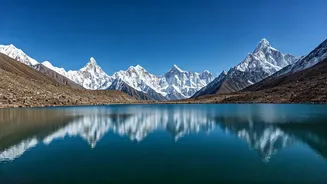Discovering the Region
Jammu and Kashmir, often referred to as 'Paradise on Earth', is a region of immense natural beauty, encompassing diverse landscapes from the snow-capped
Himalayas to lush green valleys. The region is administratively divided into the Jammu, Kashmir, and Ladakh divisions, each with its own unique characteristics. Jammu is known for its temples and cultural heritage, while Kashmir is renowned for its scenic beauty, including the Dal Lake and Mughal Gardens. Ladakh, with its high-altitude deserts and monasteries, provides a different experience altogether. These three regions combine to create a diverse and compelling travel destination. The region's geography has played a vital role in shaping its culture and history.
Cultural Heritage Unveiled
The cultural fabric of Jammu and Kashmir is a rich tapestry woven with threads of various traditions, languages, and religions. Islam, Hinduism, and Buddhism have all left their mark on the region's art, architecture, and lifestyle. The architecture, from the intricately carved wooden mosques in Kashmir to the ancient temples in Jammu and the Buddhist monasteries in Ladakh, reflects this rich heritage. The region’s handicrafts, including Pashmina shawls, silk carpets, and wood carvings, are renowned worldwide. The cuisine, a delightful mix of flavors, showcases the regional ingredients, from the aromatic Wazwan of Kashmir to the spicy Dogra cuisine of Jammu. This diverse cultural heritage significantly influences life here.
Scenic Wonders Explored
The natural beauty of Jammu and Kashmir is unparalleled, offering a visual feast for travelers. The Kashmir Valley, with its vibrant gardens and serene lakes, is a sight to behold. The Mughal Gardens, such as Shalimar Bagh and Nishat Bagh, showcase the region's artistic prowess and love for nature. The Dal Lake, famous for its houseboats and Shikara rides, provides a unique and tranquil experience. The snow-capped mountains of the Himalayas offer adventure, with opportunities for trekking, skiing, and snowboarding. Ladakh’s rugged terrain, including the Nubra Valley and Pangong Tso lake, presents a different experience altogether, displaying the raw beauty of high-altitude deserts and pristine lakes. The natural beauty attracts tourism.
Historical Significance Examined
Jammu and Kashmir has a rich and complex history, marked by the rule of various dynasties and empires. The region has been a crossroads of cultures, influencing and being influenced by various civilizations. The history can be traced back to ancient times, with the region playing a key role in the Silk Route. The Dogra dynasty played an important role in shaping the political landscape of the region, and its influence can still be seen in Jammu. The region's history is interwoven with its strategic location, making it a focal point for various conflicts and treaties. Understanding the history of Jammu and Kashmir provides context to its present, offering insight into the cultural richness and beauty.
Traveler's Essential Tips
Planning a trip to Jammu and Kashmir requires some preparation to ensure a smooth and enjoyable experience. The best time to visit the region is during the spring (April to June) and autumn (September to November) seasons, offering pleasant weather and stunning scenery. Accommodation options range from budget-friendly guesthouses to luxurious hotels and houseboats. It is recommended to dress in layers due to changing weather conditions, and to pack appropriate clothing for the activities you have planned. Respecting local customs and traditions, including the use of appropriate attire when visiting religious sites, is important. Travelers should also be aware of any travel advisories issued by their governments and stay informed regarding local safety and security conditions.













